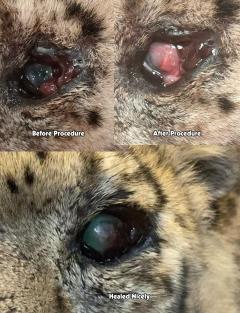Snow leopard’s eye saved by novel procedure
Dick Vet ophthalmologists perform conjunctival graft to treat corneal ulcer

Veterinary ophthalmologists from the Royal (Dick) School of Veterinary Studies have saved the sight of a rare snow leopard by performing a conjunctival graft to treat a corneal ulcer.
The team were quick to respond when contacted by Cumbria Zoo Company, after the animal failed to respond to other treatments.
Painful ulcer
Keepers at Cumbria Zoo Company noticed that one of their snow leopard’s eye had become red and inflamed.
Their veterinary team examined Wolfgang, or Wolfie as he is affectionately known, under anaesthetic and found that the soft tissues of his eyelid and part of his conjunctiva were inflamed and swollen. The snow leopard also had a large (8-10mm) full thickness ulcer in the centre of his eye that was close to rupturing.
Given the severity of the ulcer, surgical intervention was required. Veterinary surgeons from the International Zoo Veterinary Group performed a grid keratotomy procedure to promote healing.
Unfortunately, a week after the procedure, the snow leopard’s eye wasn’t showing any signs of improvement and he was at significant risk of losing his sight. The veterinary team therefore contacted R(D)SVS veterinary ophthalmologist, Dr Claudia Hartley, and asked her for help.
Conjunctival graft
Dr Hartley and Kris Houston, a Ophthalmology resident at the Hospital for Small Animals at the R(D)SVS, examined Wolfie under anaesthetic before conducting a conjunctival graft – an intricate procedure in which a piece of healthy conjunctiva is taken from the eye and placed over the ulcer and held in place using dissolvable stitches.
Within days of the procedure, Wolfgang’s eye was much improved. Under the continued supervision and care of the veterinary team at Cumbria Zoo Company, he is now back to full health.
Wolfie had a particularly nasty full thickness corneal ulcer which, if left untreated, would have undoubtedly led to him losing his sight and even his eye. I was delighted to work in partnership with the excellent veterinary team at Cumbria Zoo Company and the International Zoo Veterinary Group and am so pleased that Wolfie has made a full recovery.
A massive thank you to Claudia and the team for their treatment of Wolfgang's eye issue. We, and Wolfgang, are so lucky to have been able to draw on Claudia and the team’s expertise, when faced with such an unusual and worrying situation which could have resulted in Wolfie losing his eye should treatment have not been available. We were thrilled to see Wolfie’s eye recovering within days of the second procedure and happy to report he is now back to his lovely self!
About the Royal (Dick) School of Veterinary Studies
The Royal (Dick) School of Veterinary Studies is a one-of-a-kind centre of excellence in clinical activity, teaching and research. Our purpose-built campus, set against the backdrop of the beautiful Pentland Hills Regional Park, is home to more than eight hundred staff and almost fourteen hundred students, all of whom contribute to our exceptional community ethos.
The School comprises:
The Global Academy of Agriculture and Food Systems
The Hospital for Small Animals
The Jeanne Marchig International Centre for Animal Welfare Education
We represent the largest concentration of animal science-related expertise in Europe, impacting local, regional, national and international communities in terms of economic growth, the provision of clinical services and the advancement of scientific knowledge.

